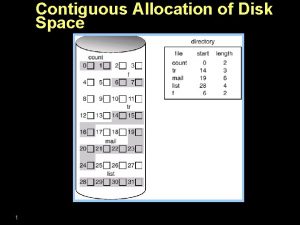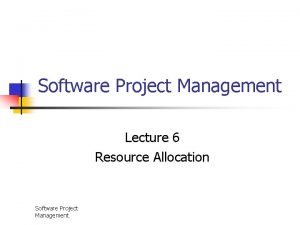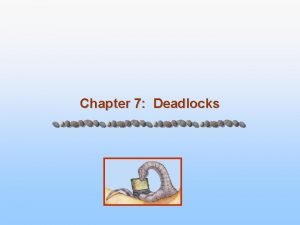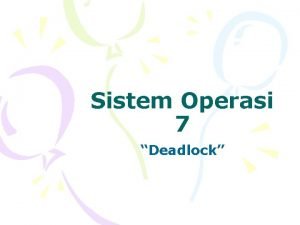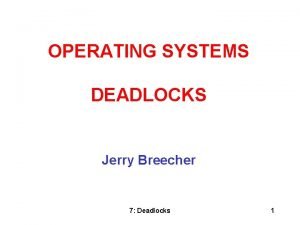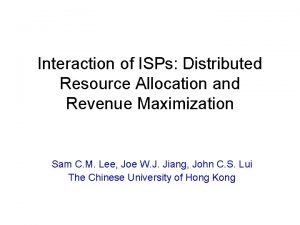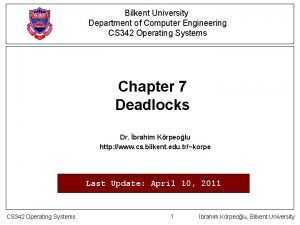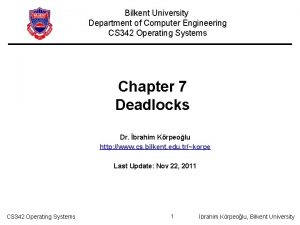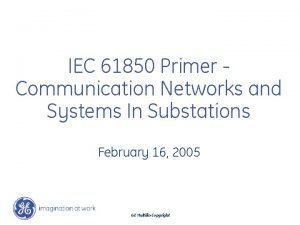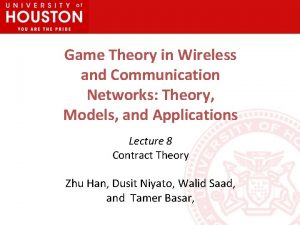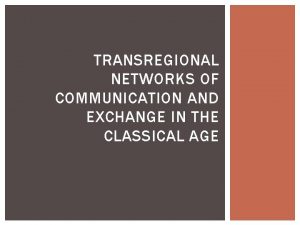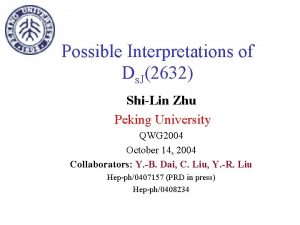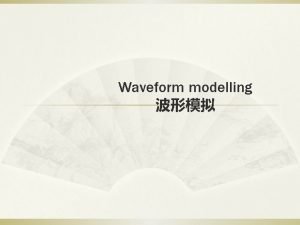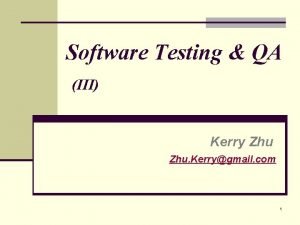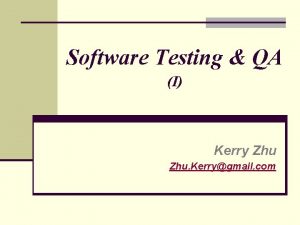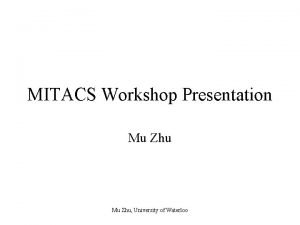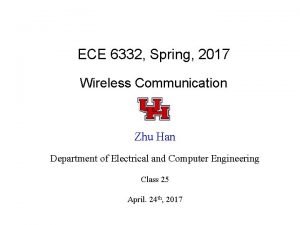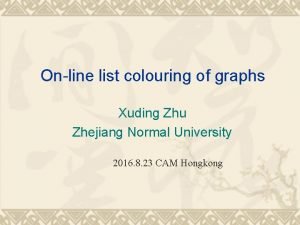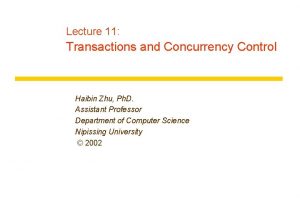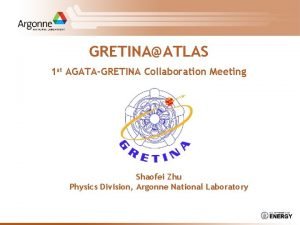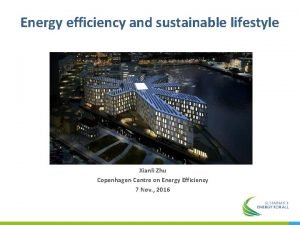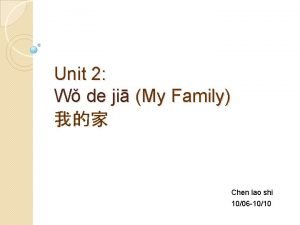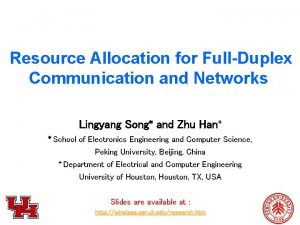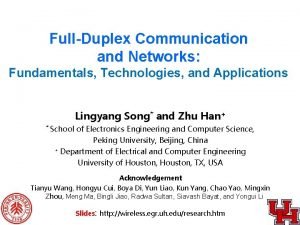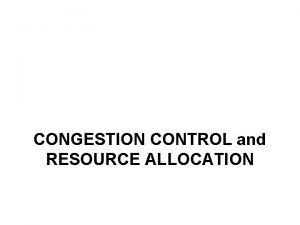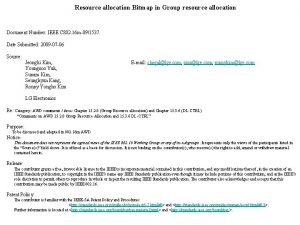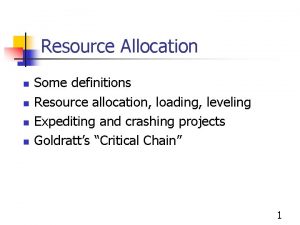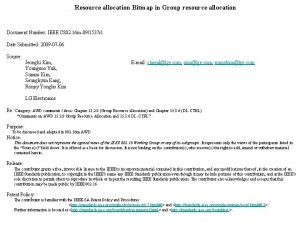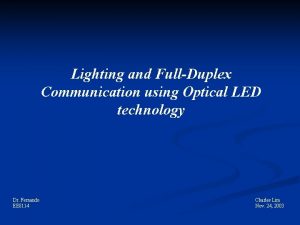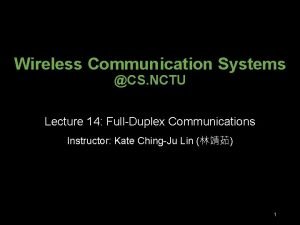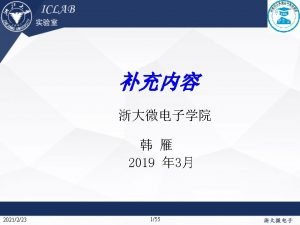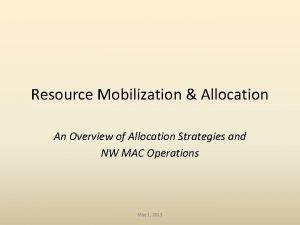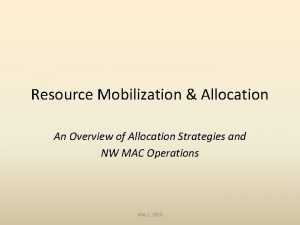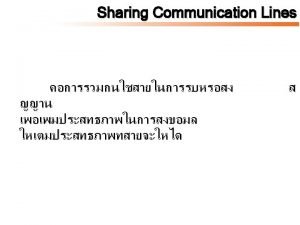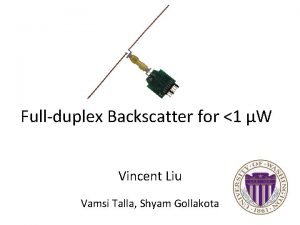Resource Allocation for FullDuplex Communication and Networks Zhu





































- Slides: 37

Resource Allocation for Full-Duplex Communication and Networks Zhu Han Department of Electrical and Computer Engineering University of Houston, TX, USA Keynote, First International Workshop on Full Duplex Wireless Communications, Globecom Workshop, Washington D. C. 2016 Slides are available at : http: wireless. eng. uh. edu/research. htm

Table of Content • Basic of Full-duplex Communications • Full Duplex Crosslayer Design – Full Duplex Cognitive Radio: Listen and Talk – Full Duplex RF CSMA/CD – Full Duplex Het. Net – Resource Allocation Summary • Conclusions • Overview of research lab 2

KPIs 6 Key Performance Indicators (KPIs) for 5 G 20. . . 10 Gbps 1000 X Capacity 10 X User Rate Anywhere 10 X Peak Data Rate (Traffic and Connections) (100 M-1 Gbps) (10+Gbps) But what is 5 G? D 2 D, small cell, Massive MIMO or full duplex? 1000 X Energy&Cost Reduce 10 X Low Latency, High reliability 3 5 -10 X Spectrum Efficiency

Background of Full-Duplex Techniques • Traditional half duplex: using orthogonal resources – Time-division duplex – Frequency-division duplex Time-division duplex Frequency-division duplex • Problems Spectral – Orthogonal resources are allocated lossfor reception and transmission. • Solutions – Same resources are allocated for reception and transmission Full-duplex Comms 4

Full Duplex Introduction • Allows communication at the same time and frequency resources. : Signal of interest : Self interference Full duplex communication • Advantages – High spectral efficiency • Same time & same frequency band – Low cost • Readily use the existing MIMO radios • Hardware advancement, etc. 5

Main Challenges Received signal • Traditional Challenges – Very large self interference • 50 -110 d. B larger than signal of interest • Depending on inter-node distance – ADC is the bottleneck • Limited dynamic range: saturation distortion. • Limited precision: signal of interest is less than noise. Signal of interest Self interference Fig. 6 Very large Self interference – 1 bit ADC is 6 d. B in SNR – Self interference costs 8 -18 bits • Need to reduce interference before ADC 6 Fig. 7 Signal after quantization

Self-interference Cancellation • Self interference channel • Passive antenna propagation suppression • Active cancelation – Active analog cancelation – Active digital cancelation Pre-mixer Post-mixer 7

Passive Propagation Cancellation • MIMO system – Example, two transmitting antenna has 180 degree difference at the receiving antenna – Multiple antenna for beamforming, nulling and selfinterference cancellation. – Challenges: For wideband, wavelength is different, so the cancellation is not good 8

Active Analog Cancelation (2) Post-mixer Pre-mixer Post-mixer x DAC ADC 9

Active Digital Cancelation • Similar to equalizer • Two-step cancellation: – Estimate the self residual interference channel h. RI through training symbols – Cancel h. RIx[n] at baseband • Useless if interference is too strong (ADC bottleneck) 10

Some existing prototypes Stanford Finland Aalto University Rice 11 Beijing University

Table of Content • Basic of Full-duplex Communications • Full Duplex Crosslayer Design – Full Duplex Cognitive Radio: Listen and Talk – Full Duplex RF CSMA/CD – Full Duplex Het. Net – Resource Allocation Summary • Conclusions 12

Listen-and-Talk Protocol For Cognitive Radio • Conventional Listen before talk • “listen-and-talk” (LAT) protocol – simultaneously sense and access the vacant spectrum. ① Yun Liao, Tianyu Wang, Lingyang Song, and Zhu Han, “Listen-and-Talk: Full-duplex Cognitive Radio Networks, ” in Proc. IEEE Globecom’ 14, Austin, TX, Dec. 2014. Best Paper Award ② Yun Liao, Lingyang Song, Yonghui Li, and Zhu Han, “Full-Duplex Cognitive Radio: A New Design Paradigm for Enhancing Spectrum Usage, ” to appear, IEEE Communications Magazine [arxiv: http: //arxiv. org/abs/1503. 03954] 13

The Listen Before Talk (LBT) Protocol • SUs sense the spectrum before transmission – Sensing and transmission separate in time domain • Discontinuous transmission • Discontinuous sensing 14

Motivation of Listen and Talk (LAT) Protocol Continuous transmission • Discontinuous – Can never fully utilize spectrum holes for transmission Continuous sensing • Discontinuous Detect PU’s state change in no – Inevitable collision and spectrum time waste 15

System Model • One PU – Non-slotted • One FD-SU pair – Each with two antennas – SU 1: secondary transmitter – SU 2: secondary receiver – Slotted 16

Listen-and-Talk Protocol (1) • Ant 1 of SU 1 senses the spectrum • Ant 2 transmits if a spectrum hole is detected simultaneously 17

Listen-and-Talk Protocol (2) • Four states of the system: – 1: only the PU uses the spectrum – 2: only SUs use the spectrum – 3: neither the PU nor SUs use the spectrum – spectrum waste • • 3 -A: change of PU’s state – PU leaves in a slot 3 -B: sensing error – false alarm – 4: both the PU and SUs use the spectrum – collision • • 4 -A: change of PU’s state – PU arrives in a slot 4 -B: sensing error – miss detection 18

Sensing Threshold (1) • Received signal varies in association with SU 1’s activity. RSI – Active SU 1 – Silent SU 1 • Thus, the varies sensing thresholds are needed according to SU 1’s state to achieve better sensing performance. 19

Sensing Threshold (2) • How to set ε 0 and ε 1? 20

Sensing Threshold (3) 21

Sensing Threshold (4): Sensing Error • Sensing error includes two parts: • false alarm and miss detection 22

Sensing Threshold (5): State Transition • State Transition: a discretetime Markov chain 23

Sensing Threshold (6): Collision Ratio • The sensing thresholds are determined by – Constraint of the maximum collision ratio 24

Power-Throughput Tradeoff (1): SU Throughput • The secondary throughput is – R is the rate of transmission – Pw is the time ratio of spectrum waste 25

Power-Throughput Tradeoff (2) Increase with RSI • Tradeoff between secondary transmit power and throughput • Optimal transmit power can be derived. 26

Adaptive Switching Spatial correlation factor Sensing duration / Slot length Adaptive switching of the two protocol Full utilization of spectrum holes Comparison of the spectrum usage Lower spectrum waste ratio under strict constraint 27

Table of Content • Basic of Full-duplex Communications • Full Duplex Crosslayer Design – Full Duplex Cognitive Radio: Listen and Talk – Full Duplex RF CSMA/CD – Full Duplex Het. Net – Resource Allocation Summary • Conclusions 28

Full Duplex CSMA/CD • Roundabout example for CSMA, CSMA/CD and Aloha • RF half duplex can only use CSMA • Full duplex enable CSMA/CD • Performance gain when traffic is high ① ② ③ Liao Yun, Tianyu Wang, Kaigui Bian, Lingyang Song and Zhu Han, “Decentralized Dynamic Spectrum Access in Full-Duplex Cognitive Radio Networks, ” IEEE International Conference on Communications (ICC), Best paper award, London, 2015. Yun Liao, Kaigui Bain, Lingyang Song, and Zhu Han, “Full-duplex MAC Protocol Design and Analysis, " appear, IEEE Communications Letters Yun Liao, Kaigui Bian, Lingyang Song and Zhu Han, “Full-duplex Wi. Fi: Achieving Simultaneous Sensing and Transmission for Future Wireless Networks, ” ACM Mobihoc (poster), Hangzhou, China, 2015. 29

Full Duplex Radom Access MAC in CRNs • With FD techniques, SUs can keep sensing during transmission. • Contention window: determine the optimal backoff length. • Handling the RSI: the RSI results in false alarm and miss detection 30

Table of Content • Basic of Full-duplex Communications • Full Duplex Crosslayer Design – Full Duplex Cognitive Radio: Listen and Talk – Full Duplex RF CSMA/CD – Full Duplex Het. Net – Resource Allocation Summary • Conclusions 31

FD Het. Net System Model • Single cell FDD OFDMA • Two-tier network • base station (BS) and femto cell access point (FAP) • MIMO is equipped in BS and FAP. • Option to either connect to BS or one of SAPs 32 32

Resource Allocation for FD Het. Net • Compared with resource allocation in HD-Het. Net – Mode selection and connection selection – Other resources such as power and channels 33 33

Numerical Results and intuition • Bias: connection to FAP and BS • Backhaul constraint • Switch between HD and FD 34 34

Resource Allocation Problem Summary • Adaptive Mode Switch – Half-duplex radio – Full-duplex radio • Power Control – High power will introduce self interference – Mode selection and power control are coupled • Transmit Beamforming – How many antenna for self interference cancellation • OFDM, Subcarrier Allocation • Link Selection • Routing 35

Conclusions • Full Duplex Basics – Key is self interference before ADC • Good thing: whole resource allocation can be redo – FD MIMO – FD Relay networks – FD Two Way Relay – FD D 2 D – FD OFDM … • Bad thing: full duplex is not always better than half duplex • Human being is full duplex Brain cancel self interference 36

Useful info for Research on FD Comms • Full-duplex communication website – http: //wireless. pku. edu. cn/home/songly/fullduplex. html • Tutorial and survey, books, technical papers, standardization… • Books – Yun Liao, Tianyu Wang, Lingyang Song, and Zhu Han, “Listen-and-Talk: Full-Duplex Cognitive Radio, ” with Springer, 2016. – Lingyang Song, Risto Wichman, Yonghui Li, and Zhu Han, “Full-Duplex Communications and Networks, ” print, Cambridge University Press, UK. • Tutorials – Lingyang Song and Zhu Han, “Resource Allocation for Full-Duplex Wireless Communication and Networks, ” IEEE International Conference on Communications (ICC), London, UK, Jun. 2015 – Lingyang Song and Zhu Han, “Full-Duplex Wireless Communication and Networks: Key Technologies and Applications, ” IEEE International Conference on Communications in China (ICCC 2014), Shanghai, China, Oct. 2014 37
 Kaizen meaning
Kaizen meaning Resource loading vs resource leveling
Resource loading vs resource leveling Linked allocation
Linked allocation Resource leveling
Resource leveling Wait-for graph
Wait-for graph Resource allocation in software project management
Resource allocation in software project management Resource allocation graph deadlock
Resource allocation graph deadlock Resource allocation graph
Resource allocation graph Deadlock sistem operasi
Deadlock sistem operasi Resource allocation graph
Resource allocation graph Distributed resource allocation
Distributed resource allocation Strategy formulation vs strategy implementation
Strategy formulation vs strategy implementation Ooqqq
Ooqqq Cs 433 bilkent
Cs 433 bilkent Cs 342 bilkent
Cs 342 bilkent Difference between virtual circuit and datagram network
Difference between virtual circuit and datagram network Backbone networks in computer networks
Backbone networks in computer networks Contoh resource loading
Contoh resource loading Iec 61850 communication networks and systems in substations
Iec 61850 communication networks and systems in substations Game theory in wireless and communication networks
Game theory in wireless and communication networks Networks of communication and exchange
Networks of communication and exchange Ds peking
Ds peking Lupei zhu
Lupei zhu Zhe yi sheng zui mei de zhu fu lyrics
Zhe yi sheng zui mei de zhu fu lyrics Kerry zhu
Kerry zhu Gmail
Gmail Man wo
Man wo Axing zhu
Axing zhu Mu zhu waterloo
Mu zhu waterloo Zhu han
Zhu han Xuding zhu
Xuding zhu Haibin zhu
Haibin zhu Shaofei zhu
Shaofei zhu Xianli zhu
Xianli zhu Zhu shi
Zhu shi Shao zhu
Shao zhu Zhù nǐ shēng rì kuài lè
Zhù nǐ shēng rì kuài lè Zhu
Zhu


